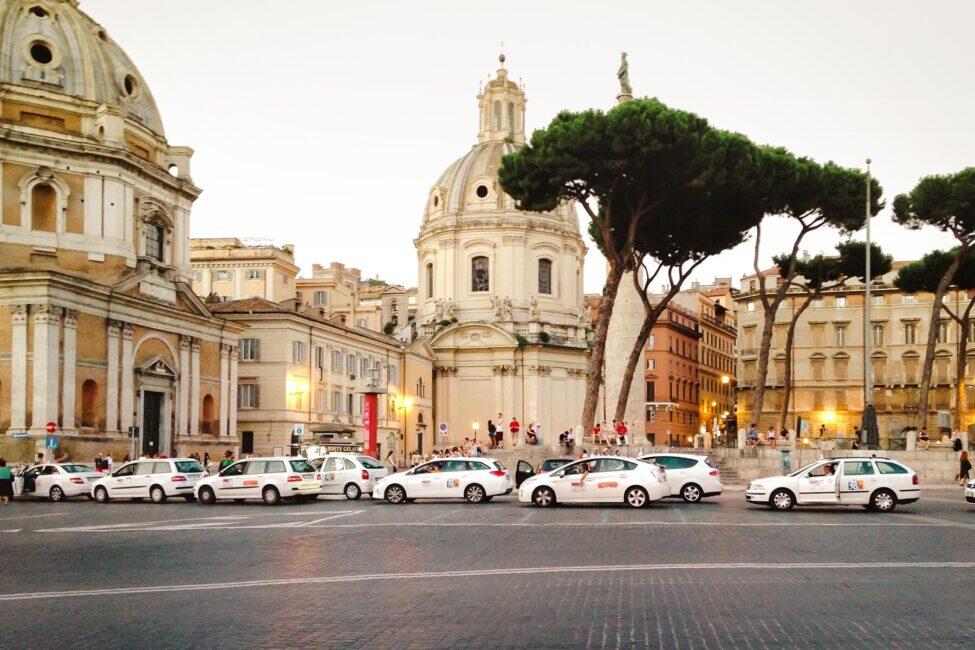Navigating the city isn’t too difficult, but there are some things you need to know.
You may have heard the old adage, “All roads lead to Rome,” but once you’re in Rome, how do you navigate the city?
The core of the centro storico—where you’ll find important monuments and piazzas like the Trevi Fountain, the Pantheon, Piazza Navona, and the Spanish Steps—is fairly compact and walkable, but chances are you’ll need to use public transit or take a taxi at some point. Sure, you could walk the 2.6 miles between the Colosseum and the Vatican, but by the time you get there, you might be too exhausted to appreciate it. Here’s what you need to know about getting around town.
Related: The Best Things to Do in Rome
Using the Metro
Rome’s metropolitana (or metro, as locals call it) is usually the fastest and cheapest way to get from point A to point B. There are only three lines, so it’s easy to navigate. The metro operates between 5:30 a.m. and 11:30 p.m. Sunday through Thursday and runs until 1:30 a.m. on Friday and Saturday nights.
Line A (red or orange on metro maps) crosses the city from northwest to southeast. Along the line, you’ll find stops near top sights like the Vatican (Ottaviano), Piazza del Popolo (Flaminio), the Spanish Steps (Spagna), the Trevi Fountain (Barberini), Piazza della Repubblica (Repubblica), and Termini Station (Termini).
At Termini, you can change to Line B (blue on metro maps), which stops in Monti (Cavour), near the Colosseum (Colosseo), Circus Maximus (Circo Massimo), and the hip neighborhood of Ostiense (Piramide).
Top Picks for You
Recommended Fodor’s Video
Line C (green on metro maps)—the newest line—currently goes from San Giovanni east to more residential areas and stops in Pigneto, an up-and-coming neighborhood full of street art and cool places to eat and drink. There are plans to extend Line C with stops at the Colosseum and Piazza Venezia, but public works projects in Rome are notoriously subject to delays, so don’t expect that to happen anytime soon.
An individual fare currently costs €1.50 (though there are rumors that it will increase to €2) and is valid for 100 minutes for a one-way metro ride (line changes included) plus any combination of buses and trams. You must validate the ticket upon first use, either in the metro turnstiles or in the automatic machines aboard trams and buses. Tickets are sold in metro stations at the ticket office (though not all metro stops have them) or in automatic ticket machines, as well as in tabacchi (shops selling cigarettes, designated by the sign tabaccaio or the letter T).

If you’re staying for a few days, you can buy a rechargeable metro card and refill it as you go or purchase an unlimited pass for 24, 48, or 72 hours, or for a week or a month. ATAC, the city’s transit agency, has also implemented contactless payment, so you can simply tap your contactless card at the metro turnstiles.
Using Buses and Trams
In addition to the metro, Rome has an extensive network of buses and trams that crisscross the city. Of course, they’re subject to traffic, so they’re usually slower than the metro, but they go to many places that the metro doesn’t reach. Buses and trams generally operate from 5:30 a.m. until 11:30 p.m. After that, there are night buses, but they don’t run as frequently and often take different routes.
If you’re standing at a bus or tram stop, you can look up at the signs to see the bus or tram number and all the stops it makes in descending order. So if you’re standing at a bus stop and you want to take the bus to a stop that appears above the stop you’re at, you need to cross the street and take the bus in the other direction.

Bus and tram drivers don’t collect or sell tickets, so you need to already have a ticket when you board. In theory, it’s pretty easy to hop on the buses and trams without paying, but every now and then, transit employees will board and do a ticket check. If you get caught without a validated ticket, the fine is €54.90 if you pay within five days or €104.90 after that.
With Google Maps, it’s pretty easy to figure out the best route to take. You could also download the Moovit app to get directions, see all the stops on individual lines, and track buses in real time.
Using Taxis
Uber isn’t really a thing in Rome. Technically, it’s legal, but drivers need to be licensed professionals, so they’re few and far between. This type of service is known in Italy as NCC (noleggio con conducente), and it’s often used by hotels that arrange airport pick-ups and drop-offs or by tour operators that arrange transportation for day trips and such. The car is usually a black Mercedes, the driver is wearing a suit, and the price is correspondingly high.

To get from place to place within the city without taking public transit, taxis are the way to go. Official taxis are white with a ”taxi” sign on top. If you come from a place where it’s common to hail a taxi in the street, you should know that that’s not the way things are done around here. Maybe you’ll get lucky, and a taxi will stop for you, but most of them will just drive right past. Instead, look for a taxi stand designed by an orange sign and go to the taxi at the front of the line. If it’s not clear who’s first, just ask. If no taxis are lined up, you usually only have to wait a few minutes before one will arrive. If you want to call for a taxi, the central dispatch number is 063570 (remember to put the country code +39 in front if you’re calling from an international phone). You can also use an app like ITTaxi or FreeNow.
Fares start at €3 on weekdays between 6 a.m. and 10 p.m., €5 on Sundays and public holidays from 6 a.m. to 10 p.m., and €7 from 10 p.m. until 6 a.m. All taxis in Rome are required by law to have a POS machine, so you should be able to pay with a credit or debit card. Every now and then, the driver will tell you that the machine is “out of order,” or he’ll try to use it and it legitimately will be out of order. It’s always a good idea to have some cash on hand or to confirm that you can pay with a card when you get in. Tipping isn’t necessary, but feel free to round up to the next euro or leave a few euros if the driver has been especially helpful with loading and unloading heavy luggage.
INSIDER TIPThere is a 10% discount for women traveling alone after 10 p.m., but you have to make sure you ask for it.
Using e-Bikes and Scooters
There was a period during the pandemic when electric scooters and e-bikes became ubiquitous in Rome, but the city has made an effort to reduce the number of them. That said, you can still find them around and can rent them using apps like Lime and Uber. Just be careful if you decide to go this route. Drivers can be rather unpredictable.




